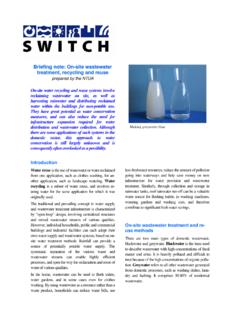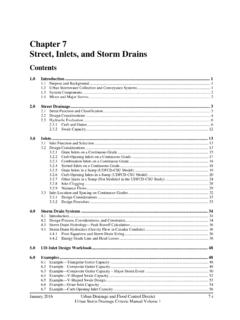Transcription of 1 PI of Water Losses in the Distribution System 2008
1 Water Losses in the Distribution System1 Performance Indicators of Water Losses in Distribution SystemSaroj SharmaApril 2008 Delft, The Netherlands2 IntroductionWater Losses in the Distribution System23 Step 1: Analysis of network characteristics and operating practices Step 2: Use appropriate tools and mechanisms to suggest appropriate solutionsUnderstanding and Managing Losses in Water Distribution Networks4 Components of Water LossWater LossPhysical loss (Real loss)Commercial loss(Apparent loss)Pipe breaks and leaksStorage overflowsHouse connection leaksMetering ErrorsWater TheftBilling AnomaliesWater Losses in the Distribution System35 Billed Metered Consumption (including Water exported) Billed Authorised Consumption Billed Unmetered consumption Revenue Water Unbilled Metered Consumption Authorised Consumption Unbilled Authorised Consumptiion Unbilled Unmetered Consumption Unauthorised Consumption Apparent Losses Metering Inaccuracies Leakage on Transmission and/or Distribution Mains Leakage and Overflows at Utility s Storage Tank System Input Volume Water Losses Real Losses Leakage on Service Connections up to point of Customer Metering Non- Revenue Water All quantities in m3/year Standard TerminologiesSource:IWA (2000)6 What is Unaccounted-For- Water ?
2 DefinitionUnaccounted-for Water (UFW) represents the difference between "net production" (the volume of Water delivered into a network) and "consumption" (the volume of Water that can be accounted for by legitimate consumption, whether metered or not). UFW = net production legitimate consumption Water Losses in the Distribution System47 Non-Revenue WaterNon-revenue Water (NRW) represents the difference between the volume of Water delivered into a network and billed authorized = Net production Revenue Water = UFW + Water which is accounted for, but no revenue is collected (unbilled authorizedconsumption). 8 Water loss is expressed as a percentage of net Water production (delivered to the Distribution System ) as m3/day/km of Water Distribution pipe System network (specific Water loss) Others-m3/day/connection-m3/day/connecti on/m pressure- Water loss as % of net Water production is the most common. -It could be misleading for systems with different net productions with same amount of real & apparent Water LossWater Losses in the Distribution System59 Magnitude of Water Losses Water loss levels (UFW or NRW) vary widely per country and within one country per city.
3 UFW values ranging from 6% to 63% have been reported (Source: Water and Wastewater Utility Data 2ndedition 1996) A certain level of Water Losses can not be avoided from a technical point of view and /or is considered acceptable from an economic point of view. 1039%42%42%15%0%5%10%15%20%25%30%35%40%4 5%AfricaAsiaLA &CN. AmericaSource:Global Water Supply and Sanitation Assessment 2000 (WHO-UNICEF)Mean UFW in Large Cities in Africa, Asia, Latin America and the Caribbean and North AmericaWater Losses in the Distribution System611 Source: Handbook for the Assessment of Catchment Water Demand and Use: HR Wallingford and DFID, UK (2003)UFW in Some Southern African Cities12 Non-revenue Water in Some Asian Cities7%18%25%30%38%40%43%51%53%55%62%0% 10%20%30%40%50%60%70%OsakaChengduHongkon gKarachiHo Chi MinhDhakaKualalumpurJakartaDelhiColomboM anilaNon-Revenue Water Source: Water in Asian Cities, ADB (2004) Water Losses in the Distribution System713 What is an Acceptable Water Loss?
4 1. It is a compromise between the cost of reducing Water loss and maintenance of Distribution System and the cost (of Water ) saved. 2. AWWA Leak detection and Accountability Committee (1996) recommended 10% as a benchmark for UFW levels and action needed< 10%Acceptable, monitoring and control10-25%Intermediate, could be reduced> 25%Matter of concern, reduction needed14 Components of Water Losses (1)Source: Water and Wastewater Utility Data 2ndEdition 1996 (WB) Country/City Year Components of UFW (%) Physical CommercialTotal Singapore 1989 4 7 11 Spain, Barcelona 1988 11 12 23 Colombia, Bogota 1991 14 26 40 Costa Rica, San Jose 1990 21 25 46 Good understanding of the relative weights of different components is important for development of a sound Water loss reduction program.
5 Water Losses in the Distribution System815 Component of UFW (%) Bangdung (Indonesia) Chonburi (Thailand) Petaling Jaya (Malaysia) Trunk mains, Distribution System 21 2 2 Physical Losses Service connections 10 34 17 Illegal connections 6 2 2 Non-physical loss Under registration and Billing 6 8 15 Total UFW % 43 46 36 Source: (Thiadens, 1996) Components of Water Losses (2)16 Charged Water Bulk supply Water Accounted for Water Other meters Water (park, fountains etc.) Unmetered usage Own Water works consumption 1% Apparent Losses Meter errors 2% Pipe breaks House connection corrosion 1% Distributed Water 100% Unaccounted for Water Real Losses Other Losses Source: (Hirner, 1997) Breakdown of Distributed Water Volume Nuremberg, GermanyWater Losses in the Distribution System917 It is impossible to eliminate all real Losses from a Distribution System - some Losses are unavoidable - some leakages are believed to be undetectable (too small to detect) or uneconomical to repair An estimate of Unavoidable Annual Real Losses (UARL) can help to evaluate the feasibility of real loss minimization (provides better understanding of real loss components).
6 Unavoidable Annual Real Losses (UARL)18 Unavoidable Annual Real Losses (UARL) The UARL is computed based on Background and Burst Estimates (BABE) Losses in the Distribution System1019 Based on a statistical analysis of international data, including 27 diverse Water supply systems in 19 countries, a method of predicting UARL has been developed and tested for application to systems with:-average operating pressure of between 20 and 100 metres;-density of service connections between 10 and 120 per km of mains;-customer meters located 0 and 30 metres from the edge of the Background (1)20 UARL (L/day) = (18 x Lm + x Nc + 25 x Lp) x PwhereLm = Length of mains in km Nc = Number of service connectionsLp = Total length in km of underground connection pipes (between the edge of the street and customer meters)P =Average operating pressure in mUnavoidable Annual Real Losses (UARL) Water Losses in the Distribution System1121 UARL in litres/service connection/day for customer meters located at edge of street22 Generalised EquationUARL (L/day) = (A x Lm + B x Nc + C x Lp) x PwhereA = specific real Losses for mains (L/day/km/m pressure)B = specific real Losses for service connections (L/connection/m pressure)C = specific real Losses for underground service pipes (L/day/km/m pressure)Unavoidable Annual Real Losses (UARL)
7 Water Losses in the Distribution System1223 Typical UK Distribution System background leakage levels at 50 m pressure Estimated leakage level Infrastructure element Low Average High Distribution mains (l/km/h) Average for all metered service pipes: - meter at property boundary (l/connection/h) - meter in-house (l/connection/h) In house plumbing Losses - average over all houses(l/property/h) (Source:Twort et al. 2000)24 A better indicator Describes the quality of infrastructure management Is the ratio of Current Annual Real Lossesto Unavoidable Annual Real LossesThe Infrastructure Leakage Index (ILI)UARLCARL =ILIW ater Losses in the Distribution System1325 The Infrastructure Leakage Index (ILI) - 226 ILI is classified into Bands A to D Different limits for developed & developing countries Each Band has a general description of performance Each Band suggests a range of recommended activitiesWorld Bank Institute Banding System to Interpret ILIsWater Losses in the Distribution System1427 WBI Banding System to Interpret ILIsVery inefficient use of resources; leakage reduction programs imperative & high priorityD8 or more16 or morePoor leakage record; tolerable only if Water is plenty and cheap; even then analyze level and nature of leakage and intensify leakage reduction efforts C4 to <88 to <16 Potential for marked improvements.
8 Consider pressure management, better active leakage control practices, and better network maintenanceB2 to <44 to <8 Further loss reduction may be uneconomic unless there are shortages; careful analysis is needed to identify cost effective improvementA< 2< 4 ILI RangeILI RangeGeneral description of real loss performance management categories BANDD eveloped countriesDeveloping countries28 WBI Recommended ActivitiesWater Losses in the Distribution System1529 Comparison of real loss performance indicatorsSource: Liemberger and McKenzie (2005)The % Losses do not reflect the huge difference in leakage performance of three (%)483872 pressure519430866 LankaIndonesiaVietnamIndicator30 Suggested apparent loss percentages for a typical Water Distribution System in South AfricaSource: Seagoet al.(2004) Thumb rule = apparent Losses is 20% of total Water Losses Water Losses in the Distribution System1631 Similar to the concept of ILI, a index for apparent loss has been recommended by IWA task force.
9 The Apparent Loss Index (ALI) Sales Waterof 5%Loss Apparent = (ALI)Index Loss Apparent32 Water audit or Water balance Meter testing and repair/replacement, improving billing procedure Leak detection and control program- network evaluation- leak detection in the field and repair Rehabilitation and replacement program Corrosion control Pressure reduction Public education program; Legal provisions Water pricing policies encouraging conservation Human resources development Information System developmentControlling Water Loss Water Losses in the Distribution System17 Existing real lossesEconomic levelUnavoidable real lossesImproved response time for leak repairImproved System maintenance, replacement, rehabilitationPressure management and level controlMore efficient leak detectionFour components of an active real loss management programSource:Thornton (2002)Existing apparent lossesEconomic levelUnavoidable apparent lossesReduction of theft by Education Legal action Prepay measures Pressure limitation Flow controlReduction of computer error by Auditing Checking Routine analysis UpgradeReduction of human error Training Standardizing Reporting Auditing Reduction of meter error by Testing, Sizing ReplacementFour components of an active apparent loss management programSource:Thornton (2002) Water Losses in the Distribution System18 IWA recommended performance indicatorsRatio of CARL to UARLI nfrastructure Leakage IndexDetailedOperational:Real lossesBest traditional basic performance indicatorm3/service line/day, when System is pressurizedBasicOperational.
10 Real lossesUnsuitable for assessing efficiency of management of Distribution systemReal loss as % of System input volumeBasicInefficiency of use of Water resourcesAllows different unit costs for NRW componentsValue of NRW as % of annual cost of running systemDetailedFinancial:NRW by costCan be calculated from simple Water balanceVolume of NRW as % of System input volumeBasicFinancial:NRW by volumeRemarksPerformance IndicatorLevelFunctionSource: Adapted from Thornton (2002) 36 For systems with per capita consumption of less than 150 l/day the general rule for Water loss level is:Good condition of System < 250 Litre/connection /dayAverage condition 250 -450 Litre/connection/dayBad condition of System > 450 Litre/connection/day Another guideline for the Water loss level is the Benchmark Litre/km mains/day:Good condition of System < 10,000 Litre/km main/dayAverage condition 10,000 18,000 Litre/km main/dayBad condition of System > 18,000 Litre/km main/dayGuideline for Water Loss Level Source: Gerhard Zimmer (Experiences from Kfw funded programs) Water Losses in the Distribution System1937


